[ZX Spectrum, MC Lothlorien]

– Lieutenant Narwhal ! The new bridge mission has arrived !
– What kind of force can I count on this time ?
– Some artillery. That’s all that matters.

Johnny Reb is the last of the July 1983 MC Lothlorien games, and the AAR is going to be brief: with the emulator running at 250% speed a typical battle takes around 10 minutes.
A session begins with far more options than the average Lothlorien game, including their first-ever multiplayer mode and the ability to select your (cosmetic) side. I choose the Union, determine the battle’s duration (12 turns, I could have also chosen to fixed duration), and construct my army: 8 infantry, 4 cavalry, and 2 artillery – the AI gets the same units. However, their placement on the battlefield is random.

My initial move is to command one of my units to swim across the river – it promptly drowns. Heeding this lesson, my remaining infantry and cavalry units move toward the bridge.
Artillery is the sole unit capable of ranged combat. It can only fire in cardinal or ordinal (NW, SW, etc.) directions. The projectile detonates upon impact, damaging its target and the surrounding 8 tiles. I use my northern gun to target the enemy artillery and direct my southern gun to move north to eventually align with the bridge.
During its turn, the AI retaliates against my northern gun and fires at some of my clustered units.
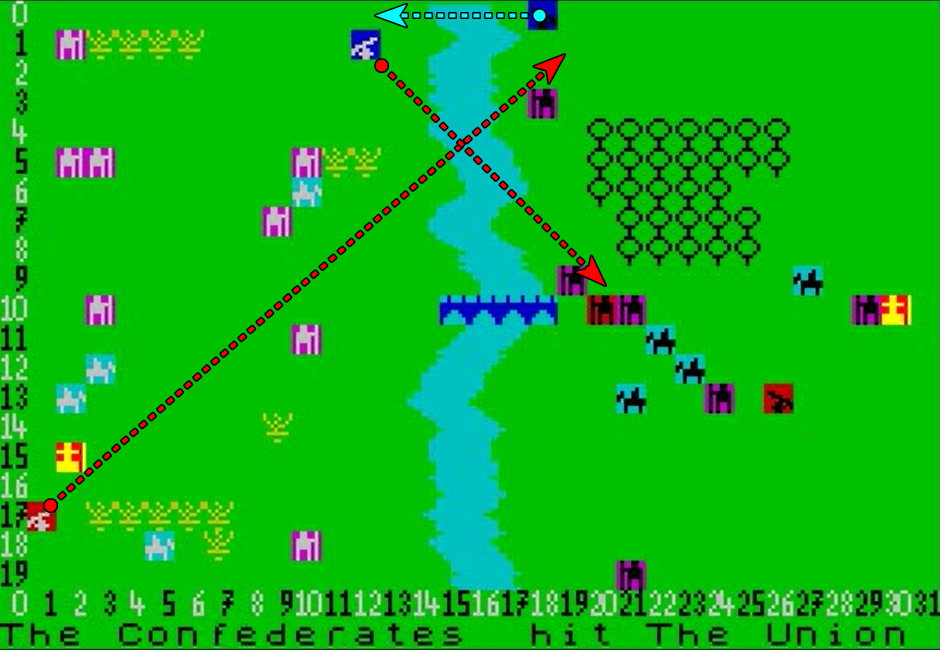
The following turn, my northern gun eliminates the Confederate northern gun before being destroyed itself. The first combat also occurs in the middle of the bridge. “Combat” in Johnny Reb takes place at the end of the Confederate turn if units have been adjacent during either player’s turn (even if the AI moves away, combat still happens). Losses are deterministic and affect both sides.

The Confederates continue their assault on the bridge and use their cavalry to swim across the river. It is damaged, but it makes it through.

Positioned at the top of my force, their cavalry would perish pointlessly if the game was realistic, but in this ruleset it is ideally situated to inflict significant damage. In Johnny Reb, a unit deals the same damage in contact (including diagonally) whether next to one or five units. Since it can only die once, it’s a sound tactics to send units solo into an enemy force.
In any case, that’s the final turn with any subtlety. My gun is now aligned with the bridge, and I pummel enemy groups turn after turn.
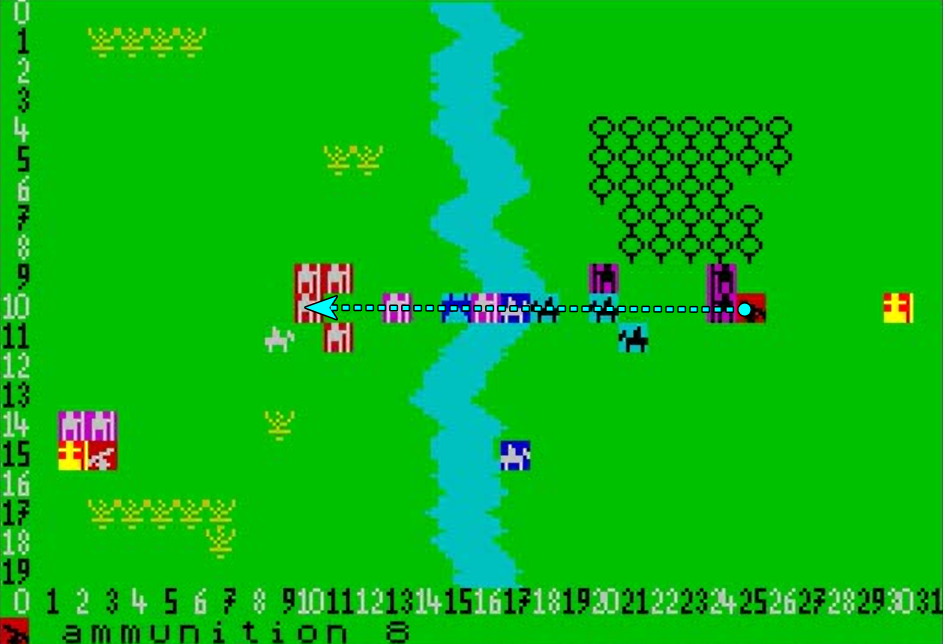
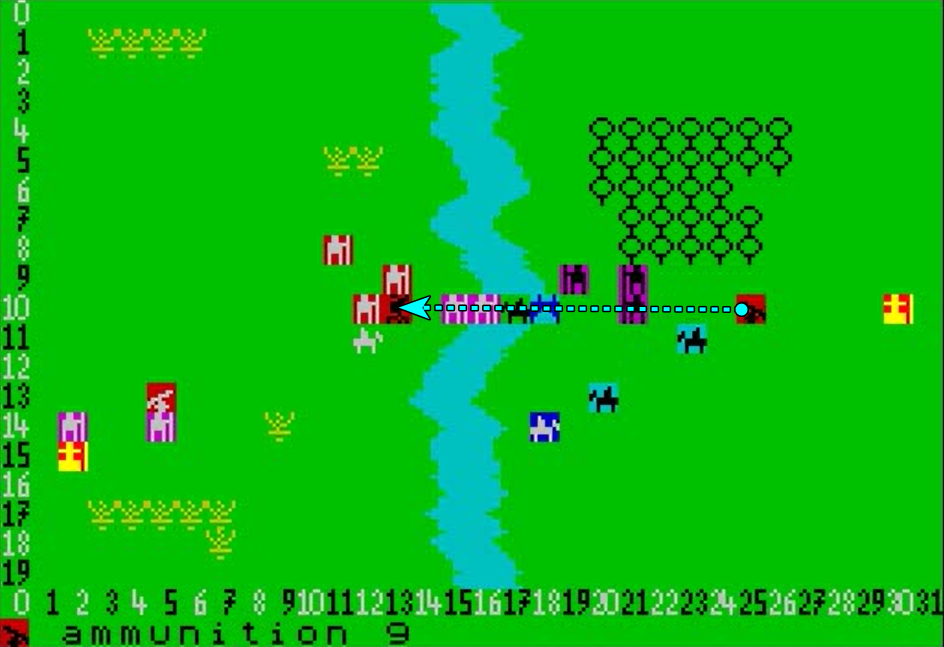
Officially, my guns have limited ammo, but I begin with 10 rounds and sporadically gain more, so for practical purposes, I can fire every turn
The final turn looks like this :
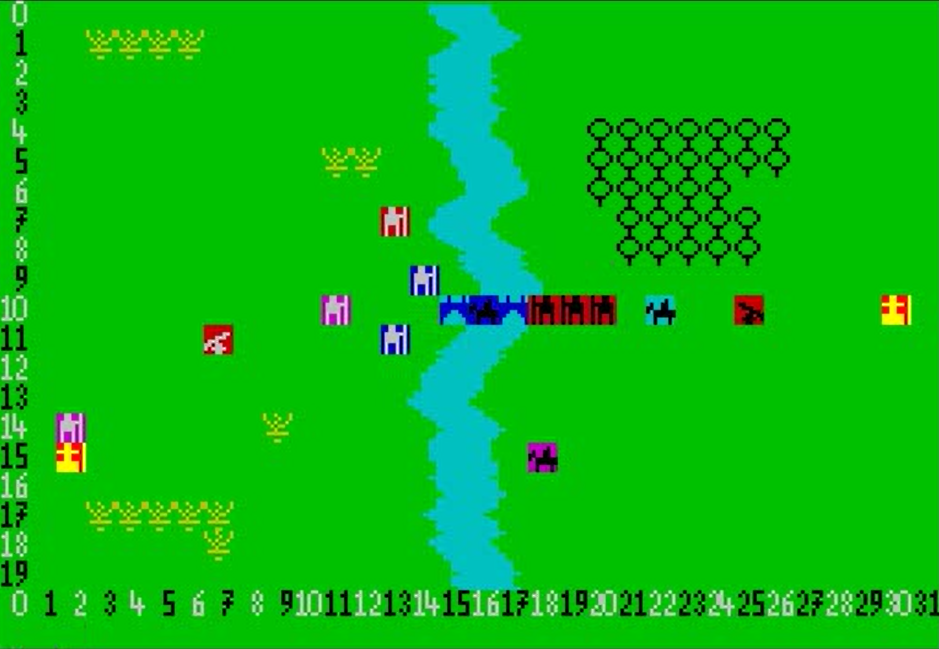
Before I can act, the game determines that I have such a decisive advantage that I win without waiting for the 12th turn! I’m fine with that.

I’m not certain why my victory was so obvious from the point of view of the computer (it was still 6 units against 6 units), but I was about to destroy that gun and then safely target the remaining units – so well, yes I know I had won.
Rating & Reviews
Johnny Reb by Andy Pugh, published by MC Lothlorien, UK
First release : July 1983 on ZX Spectrum
Tested on : ZX Spectrum emulator (Fuse)
Total time tested : 90 minutes
Average duration of a battle : 10 minutes
Complexity: Easy (1/5)
Would recommend to a modern player : No
Would recommend to a designer : No
Final Rating: Totally obsolete
Ranking at the time of review : 65/92
Summary :
Johnny Reb is the first Lothlorien game to feature multiplayer gameplay and some customization options. However, its poor balance and inadequate map design render it pointless to play.
Immersion – Very poor.
UI, Clarify of rules and outcomes – Adequate.
Systems – Terrible. Artillery thrashes everything else, and the rules for melee combat favours sending units one by one.
Scenario design & balancing – Terrible. The player can select their units for battle, and the map exhibits slight variations each time. Unfortunately, the map always features a central bridge, and attempting to swim across the river is almost always fatal. Consequently, regardless of the chosen units, all battles appear strikingly similar: both cavalry and infantry units cluster around or on the bridge, where they are ultimately decimated by artillery fire.

There is an option to let the AI build its own army, but do not use it. The AI knows that arty is OP and has infinite ammo, so this will happen :

The AI is not good. Imagine that : it does not prioritize my artillery when given the chance !
Did I make interesting decisions ? No. I just blasted OPFOR with artillery as they aligned in front of the bridge.
Final rating : Totally obsolete. The only nice thing I can say about Johnny Reb is that it is easy and quick to play.
Contemporary Review
Johnny Reb garnered some positive reviews (Crash in February 1984 : “Hours of fun”, Personal Computer Games in August 1984 : “It will take quite a while before you can totally master the game”, ZX Collection, Winter 1984 : “the game is very absorbing“). However, I am not alone in my evaluation of this game: Games Computing in March 1984 asserts that the game is condemned by a few fatal flaws, including “the computer not providing a very strong opponent” and “the artillery being incredibly powerful“. Even in two-player mode, the game reportedly devolves into “a virtual stalemate with a desultory artillery duel.”
The game seems to have been genuinely popular and was ported on most of the platforms which mattered in Europe : Oric, Dragon, BBC Micro, even on the Commodore 64 , the Amstrad CPC and the obscure Memotech MTX. It eventually sold according to designer Andy Pugh (as quoted on Spectrum Computing) more than 20 000 copies – and I am not sure whether that number counts the international sales given I found mentions of the game in most European languages. MC Lothlorien would even release a Johnny Reb II in 1986.
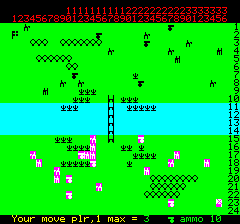
We have now covered all of MC Lothlorien’s 1983 games. M.C. Lothlorien released another wargame in December 1983, Dreadnoughts, which seems right up my alley. Alas, it’s exclusively a two-player game so I won’t be covering it. But if you are a ZX Spectrum amateur, despair not, about half of the remaining games on my 1983 list are for this platform. But first, I will finally complete my Ratings & Reviews for Excalibur.
Addition 05/04/2025:
After Johnny Reb’s designer, Andy Pugh, commented on this article I contacted him through email to have more information on the “story” of Johnny Reb. Given he is the only source I have on the topic and that his account is well-written, I elected to copy his answer directly below:
Like many 14 year olds, I avidly read the Hornblower books by C S Forester. I wanted to write a game set in that era, and created “Privateer” on the ZX81. If you look at that it even uses character names from the Hornblower books, with “Mr Bones” reporting the damage. I went to a “Computer Fair” in Leeds, and decided to see if anyone wanted to buy my game. To this day I have no idea how 14 year old me summoned up the bravery to talk to any of the developers, but I asked someone on the Lothlorien stand (who turned out to be Roger Lees) “Do you ever buy games off people“. It turned out that they were looking to expand from text-only games to graphical games, and asked me to send them a cassette.
They ended up paying me £75 for the ZX81 version of Privateer, with the offer that they would loan me one of the just-released Spectrums if I would re-write the game for that. (As I recall you couldn’t load ZX81 data onto a Spectrum, so it really was a complete re-write). The deal was that when the game was completed I would get to keep the Spectrum as the fee.
After finishing Privateer for the Spectrum (and feeling really cool, being one of the new breed of “Computer Whizz Kids” than the newspapers kept talking about), I was trying to think of my next game idea, and my cousin, who was just starting out in table-top wargaming suggested that this would be a good application for a computer.
So, never having wargamed at all, with some small hints from my nearly-equally inexperienced cousin, I wrote the game that came to be called “Johnny Reb”. Initially I think I thought of it as being set in the English Civil War, but Lothlorien decided that it would be better as in American Civil War. It’s a complete accident that just before the game starts the computer informs you that “The confederates have white men, the Union has black men”
After that, I started a more arcade-game-ey game, mainly written in machine code (literally, hand-converting assembler into hex using the back pages of the manual). That never got finished (even after getting my hands on an assembler) as I was too busy with my studies. I also made a start on a version of the arcade game “Track and Field” using the rather interesting “White Lightning”FORTH-based game development system. However I decided that the Spectrum keyboard wasn’t suitable for the button-mashing of that game. (This didn’t seem to bother Ocean, who went on to release “Daley Thomson’s Decathlon” to the misfortune of keyboards and joysticks worldwide).
I did a couple of loading screens, then my Spectrum keyboard died. In my first year at University I attempted to transplant the motherboard into a terminal keyboard, not realising that it was capacitive, and then without a computer, and with many, many new interests at University, drifted away from games programming.
I briefly mentioned Privateer in my Paras article. In further email exchange, Pugh told me he was paid $375 for Johnny Reb, which he was told sold a whooping 20 000 copies.